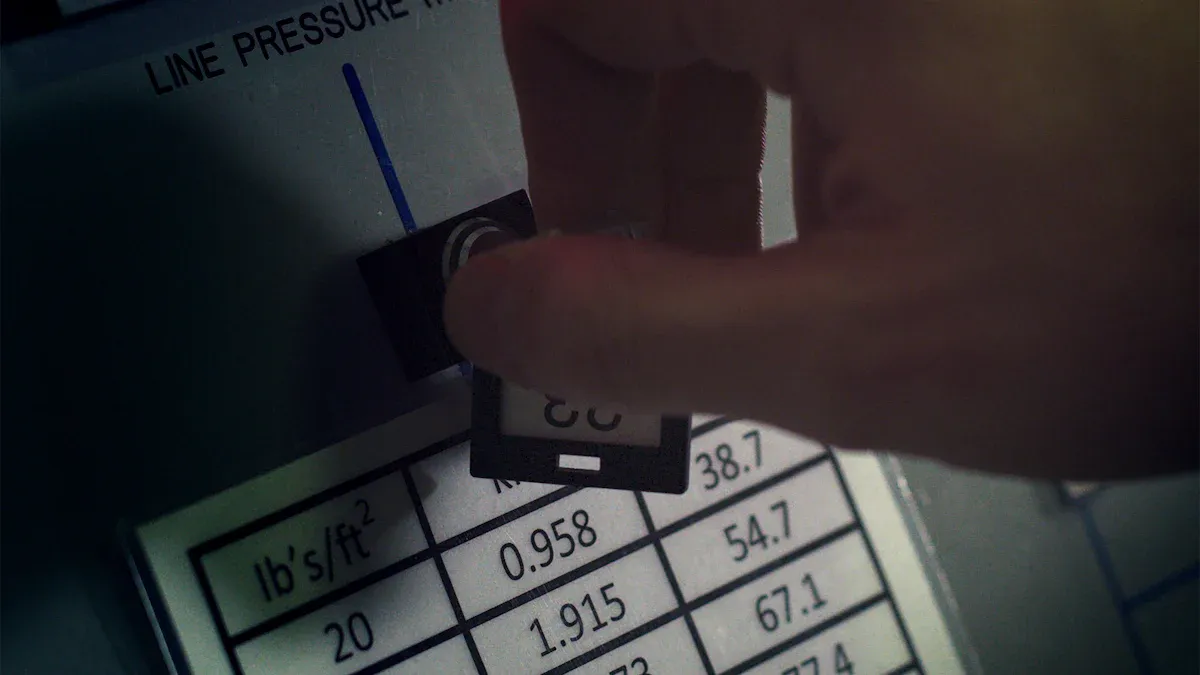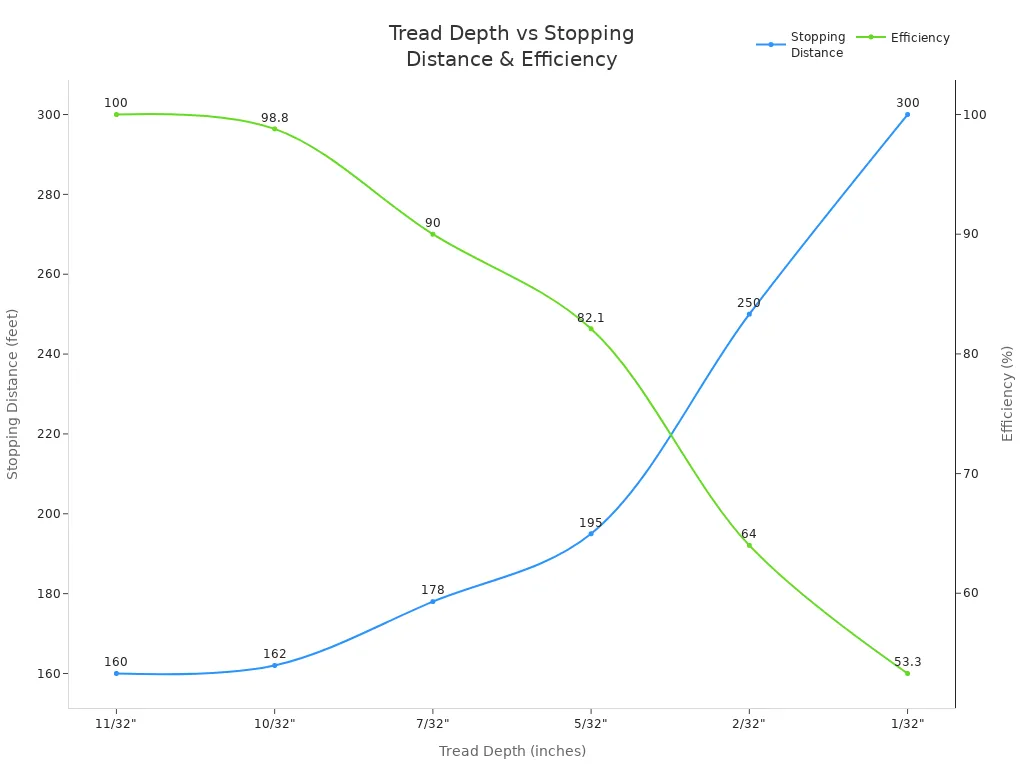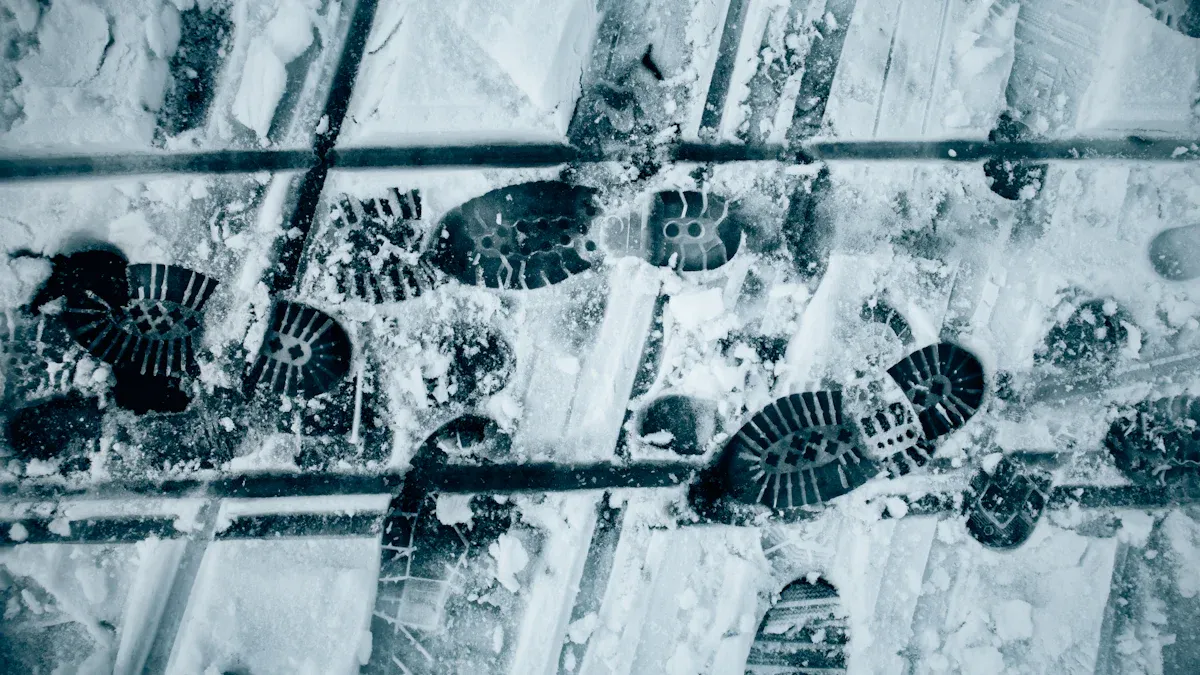
Before you start your trip, check your tire tread depth. This is important for your safety and how well your car works. Worn tires can make it harder to stop and steer. A handheld tire tread scanner helps you do this quickly. It makes sure you are ready for any adventure.

Viktiga insikter
Kontrollera ditt däckmönsterdjup often. This keeps you safe and helps your vehicle work better. Aim for at least 4/32 inches for good grip, especially when it’s wet.
Use a handheld tire tread scanner. It gives quick and accurate measurements. This tool saves time and helps you check tire condition easily.
Keep a tire maintenance log. Write down installation dates, mileage, and service actions. This helps you watch tire wear and plan when to replace them.
Användning av ett Däckmönsterscanner

What is a Tire Tread Scanner?
A tire tread scanner is a useful tool. It helps you quickly and accurately measure your tire tread depth. Unlike old methods, you don’t need to kneel and use a ruler. These scanners use smart technology for instant readings. For example, the SnapSkan device lets you check your tire tread depth while driving over it. You don’t even have to get out of your car! Another choice is Anyline, which works with any smartphone that has a camera. It uses computer vision and AI to give you exact digital measurements. This makes it a great option for busy SUV owners.
Importance of Tread Depth for SUVs
Mönsterdjup är mycket viktigt for your SUV’s performance and safety. Here are some key points to think about:
The minimum legal tread depth in most states is 2/32 of an inch.
Federal rules say the minimum tread depth is 4/32″ for steering tires and 2/32″ for non-steering tires.
Deeper tread helps your tires move water away, which lowers the chance of hydroplaning. When tread depth goes below 2/32 of an inch, your SUV can lose control in wet weather.
Keeping the right tread depth improves your vehicle’s grip on the road. It also makes driving safer for you and your passengers. Regularly using a tire tread scanner helps you check your tires’ condition. This makes it easier to stay safe while driving.
Trick 1: Quick Measurement Techniques

Instant Readings
A handheld tire tread scanner makes it easy to measure tread depth. To get quick readings, just put the gauge into the tread grooves. The device shows the depth in seconds. This way is much faster than older measuring methods. You can check all four tires in just a few minutes!
Here’s a quick reference table for tread depth recommendations:
Tread Depth (32″) | Rekommendation |
|---|---|
6/32″ or higher | Sufficient |
5/32″ | Think about replacing if driving in snowy or icy conditions |
4/32″ | Think about replacing if driving on wet roads |
3/32″ | Think about replacing now; very close to being worn out |
2/32″ eller mindre | Tires are legally bald; must be replaced now |

Identifiera slitagemönster
While checking tread depth, look for wear patterns. They can tell you a lot about your SUV’s condition. Here are some common patterns to notice:
Inre eller yttre axelslitage: This might mean wheel alignment problems, which can change handling.
Mittslitage: If the center of the tire is worn more than the edges, your tires may be overinflated.
Kant- och axel-slitage: This shows underinflation, which can cause blowouts.
Cupping/Skalningsslitage: This often means suspension issues, affecting stability.
Fläckvis, diagonalt slitage: This shows tire imbalance, often from not rotating them often.
By using your tire tread scanner often, you can find these problems early. This smart approach keeps your SUV safe and working well on the road.
Trick 2: Efficient Tire Checks
Systematic Approach
When you check your SUV’s tires, a good plan saves time. It also helps you be accurate. Here’s an easy method to follow:
Rotate your tires often to keep wear even.
Check tire pressure regularly for better handling and fuel use.
Använd en däckmönsterscanner to watch for uneven wear.
Look for damage on tires to avoid problems.
By doing these steps, you can keep your tires in good shape and ready for driving.
Consistency Across Tires
Being consistent is important for tire care. Regular checks can help your tires last longer. Here are some key points to think about:
Good suspension care can stop early tire replacement.
Suspension problems can cause uneven tire wear, which shortens tire life.
Regular tasks like tire rotations, proper inflation, and alignment checks help keep tires healthy.
Keeping tires inflated correctly helps them wear evenly, while regular rotations stop uneven patterns.
By making tire checks a regular part of your car care, you’ll keep your SUV safe and running well. Remember, a little work goes a long way in making your tires last longer and work better!
Trick 3: Utilizing Tread Wear Indicators
Recognizing Indicators
When checking your tires, look for built-in tread wear indicators, also known as wear bars. These are small, raised bars located in the tread grooves of your tires. They serve a crucial purpose: when these bars become level with the tread surface, it’s time to replace your tires for safety. Here’s what to keep an eye out for:
Wear Bars: Raised bars that indicate when tread depth is too low.
Flush Level: If the wear bars are flush with the tread, your tires are worn out.
These indicators make it easy for you to assess your tire’s condition without needing specialized tools. Just a quick glance can tell you if your tires are ready for replacement.
Interpreting Readings
To accurately assess your tire safety, follow these steps:
Measure the tread depth using a tire tread scanner.
Interpret the readings:
6/32″ or More: Your tires are generally considered safe.
4/32″ to 5/32″: Start considering replacement soon, especially if you drive in wet conditions often.
3/32″ or Less: It’s time to replace your tires for safety.
Check multiple spots on the tire: Measure the tread depth in three locations across the tire’s width: the inner edge, the center, and the outer edge.
By regularly checking your tread wear indicators and understanding what the readings mean, you can keep your SUV safe and ready for the road. Remember, a little attention to your tires can go a long way in ensuring your safety on every trip!
Trick 4: Comparing with Manufacturer Recommendations
Recommended Tread Depths
Knowing what the tire makers say is very important for your SUV’s tires. Most tire companies say to change tires when the tread depth hits 4/32 tum. This depth is key because it affects how well your car stops, especially on wet roads. Here’s a quick look at what you should remember:
4/32 tum: This is the usual advice for replacing tires. Many tire shops, like Parrish-McIntyre Tire Co., have followed this rule for a long time.
Säsongsbetonade hänsyn: In summer, you might be okay with 4/32 inch, but winter is different. Traction is very important, so think about changing your tires sooner.
Laglig minimi: The legal minimum tread depth is often 2/32 tum, but this is not safe for driving. You should aim for at least 4/32 tum for better safety.
Bytguider
Most European car groups agree with this advice. They suggest changing tires at 4/32 tum because lower tread depths can lead to bad braking.
“Tire replacement is recommended at a tread depth of 4/32 inches. It is advised to begin shopping for new tires at this depth to ensure safety and performance.”
By keeping these tips in mind, you can make smart choices about your tires. Regular checks and timely replacements will help keep your SUV safe and ready for any trip. Remember, your tires are your only contact with the road, so don’t ignore their condition!
Trick 5: Documenting Findings
Tire Maintenance Log
Keeping a tire maintenance log is very important for SUV owners. This log helps you remember key details about your tires. Here are some good practices to follow:
Förklaring | |
|---|---|
Track installation dates | Knowing when a tire was put on helps you know when to replace it based on its age. |
Log mileage | Keeping track of how many miles you drive helps you plan tire rotations every 5,000-10,000 miles as suggested. |
Record service actions | Writing down all service actions done on each tire helps you track what maintenance is needed. |
By keeping this log, you can easily see patterns in tire wear and performance. This smart approach keeps your SUV safe and ready for driving.
Benefits of Documentation
Regularly writing down your tire tread depth and maintenance findings has many benefits:
Du kan kontrollera däckmönsterdjup to know when your tires are worn and need to be replaced.
Changing tires when tread depth hits 4/32″ helps with wet weather performance, lowering the chance of hydroplaning.
Using the penny test to check tread depth is an easy way to see if you need new tires; if you can see Lincoln’s head, it’s time to replace the tire.
Keeping a detailed record not only makes you safer but also helps your tires last longer. Plus, using digital tools like the HVI App can make this easier. This app has features for managing tires, helping you keep track of your tire maintenance easily.
By making documentation a regular habit, you’ll keep your SUV in great shape for every trip. Remember, a little effort goes a long way in keeping you safe on the road!
Checking your tire tread depth is very important for your safety. It helps your tires grip the road, especially when it’s wet. This can lower the chances of accidents. Experts say you should check your tires every month and before long trips. Make tire checks a regular part of getting ready to travel. This will help you have a safe and fun trip! 🚗✨
Vanliga frågor
Hur ofta bör jag kontrollera mitt däckmönsterdjup?
Du bör kontrollera ditt däckmönsters djup every month and before any long trips to ensure safety.
What tools do I need to measure tread depth?
A handhållen mönsterdjupmätare is the best tool. You can also use the penny test for a quick check.
When should I replace my tires?
Replace your tires when tread depth reaches 4/32 inches or less, especially if you drive in wet conditions.
Se också
Vikten av att övervaka däckmönsterdjup för säkerhet






